Hey, wanna boost your garden with homemade organic fertilizer? It’s easier than you think, and I’ve got the scoop. Start by grabbing kitchen scraps like banana peels, coffee grounds, and eggshells, then toss them into a 5-gallon bin with dry leaves. Mix it up every few days to keep things airy. Stick with me to learn how this turns into gold for your plants!
Contents
Composting Kitchen Scraps
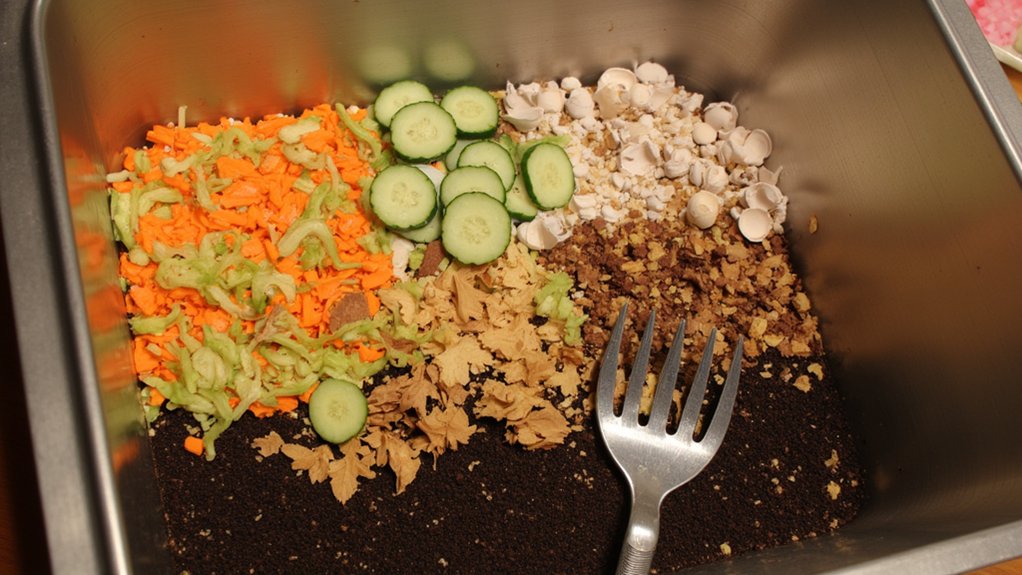
Hey, let’s plunge into composting kitchen scraps, a super simple way to turn waste into garden gold. You’ve got veggie peels, coffee grounds, and eggshells piling up, right? Start by grabbing a small bin, about 5 gallons, for your kitchen counter.
Place a layer of dry leaves or shredded paper at the bottom, roughly 2 inches thick, to absorb moisture. Then, toss in your scraps daily, covering them with another thin layer of dry material. Keep the bin aerated by mixing it every 3-4 days with a fork. In 2-3 months, you’ll see dark, crumbly compost ready for your garden.
Don’t let it get too wet; add dry stuff if it’s soggy. Store it under the sink, and you’re set!
Using Banana Peels
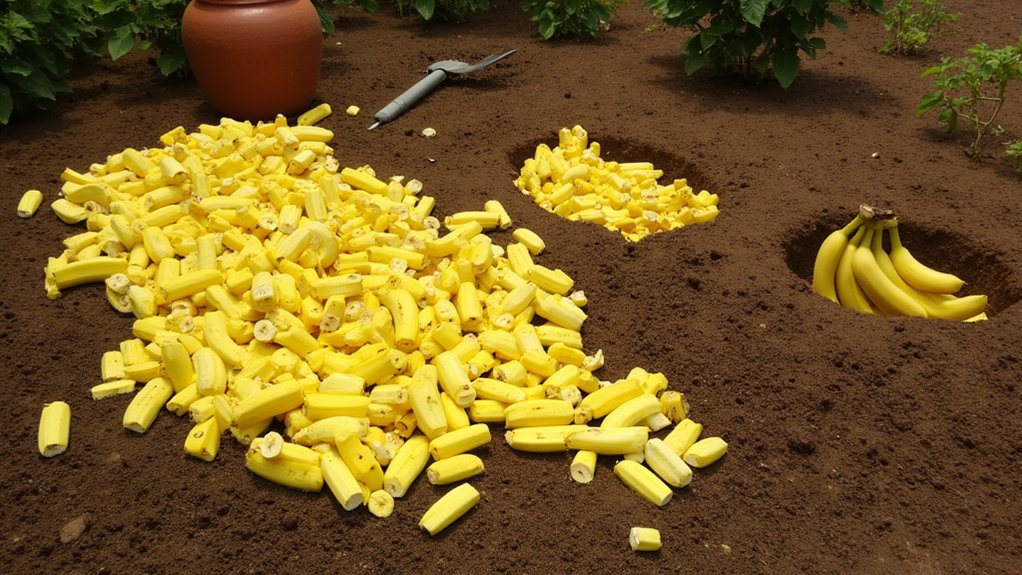
Folks, let’s explore using banana peels, a fantastic trick for boosting your garden’s health. You’ve got a goldmine in your kitchen with those peels. They’re packed with potassium, phosphorus, and calcium, perfect for plants like roses or tomatoes.
Start by collecting peels from 2-3 bananas. Chop them into small, 1-inch pieces for faster breakdown. Bury these bits directly in your garden soil, about 2-3 inches deep, near plant roots. This releases nutrients slowly over 1-2 weeks.
Alternatively, soak the peels in a jar of water for 48 hours. Use this liquid to water your plants, giving them a quick nutrient hit. Don’t toss those peels; they’re a cheap, effective fertilizer. Keep at it, and watch your garden thrive!
Brewing Compost Tea
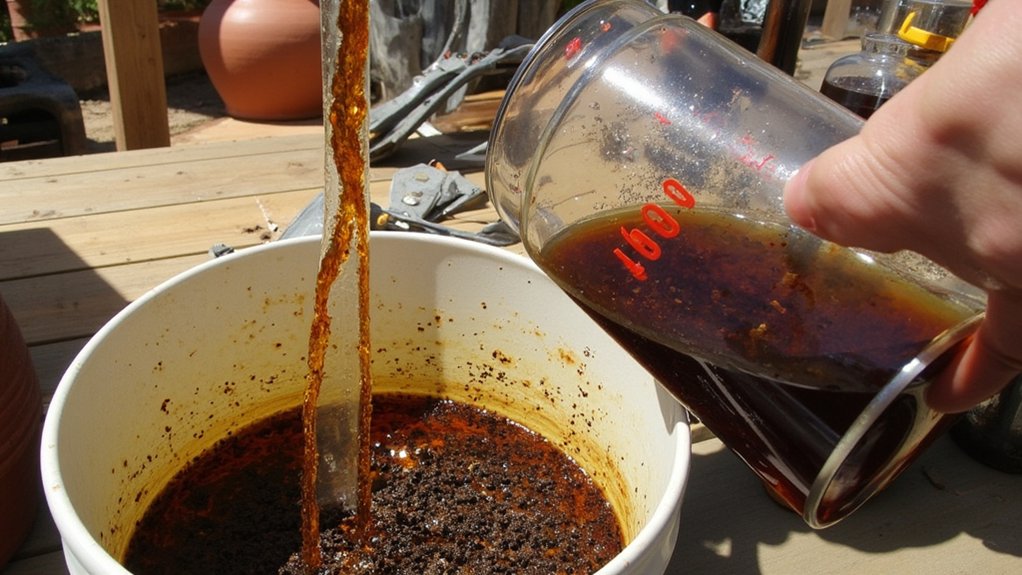
Let’s plunge into brewing compost tea, a powerful way to nourish your garden. You’ve got compost, so let’s turn it into liquid gold. Grab a 5-gallon bucket, and fill it two-thirds with water, preferably non-chlorinated.
Start by adding about 2 cups of well-aged compost into a breathable bag, like an old pillowcase. Submerge it in the water, tie it off, and let it steep for 24-48 hours. Stir occasionally, ensuring the nutrients mix well, and watch for a rich, dark color. You’ll need to aerate the mix if possible—use a small aquarium pump for best results. After steeping, remove the bag, and dilute the tea with water, aiming for a 1:10 ratio. Apply it directly to your plants’ soil for a nutrient boost!
Collecting Grass Clippings
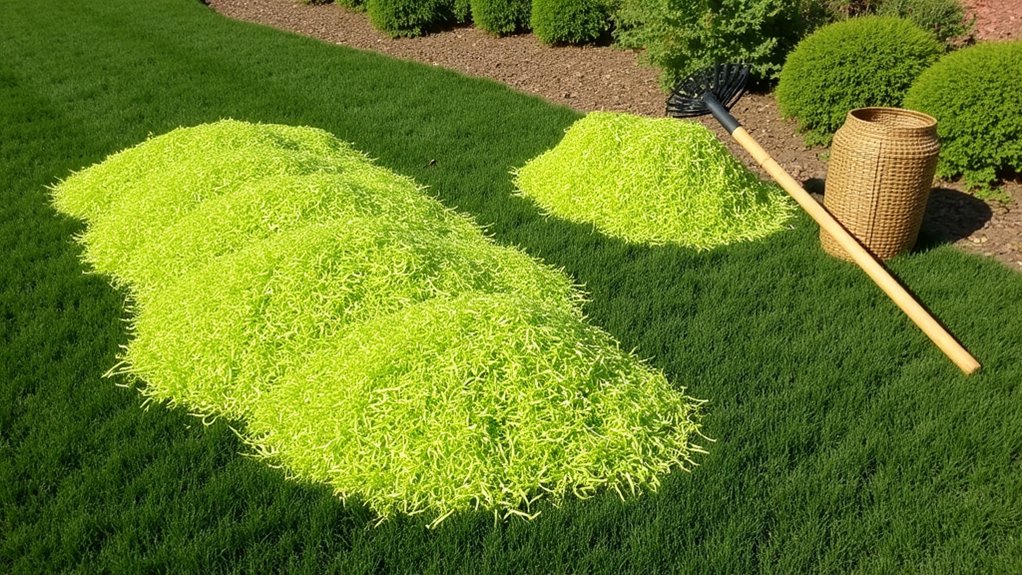
Another great resource for organic fertilizer is right in your yard—grass clippings. You’ve got a goldmine after mowing, so don’t waste it. Collect those fresh clippings, ideally within a day, to keep them nutrient-rich.
Start by grabbing a rake or using your mower’s bag attachment, if it’s got one. Aim to gather about 2-3 inches of clippings from a standard lawn, roughly 5-10 pounds, depending on size. Avoid clumps with dirt or debris; you want clean, green material for the best results.
Store them in a breathable sack or bin, not plastic, to prevent rot. Check every 2-3 days for moisture—too wet, and they’ll mold. Dry them slightly in the sun if needed, and you’re set for composting!
Utilizing Coffee Grounds
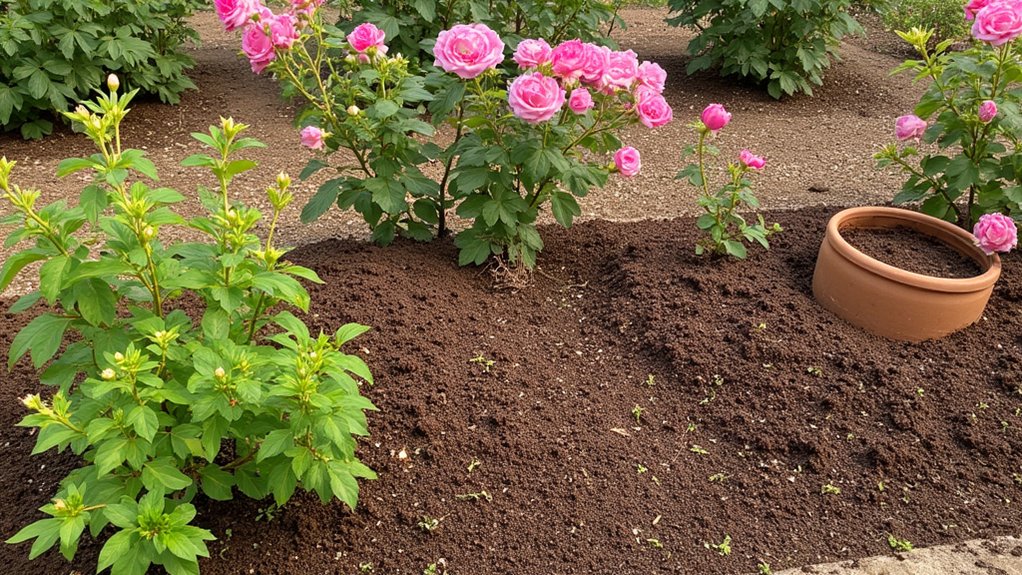
Ever thought about using your morning coffee leftovers for something useful? Don’t toss those used coffee grounds, because they’re a fantastic addition to your homemade organic fertilizer. They’re rich in nitrogen, a key nutrient for plant growth, and they improve soil structure.
Start by collecting your daily coffee grounds in a small container. Once you’ve got about 2 cups, mix them into your compost pile or spread them directly around acid-loving plants like roses or blueberries. Do this weekly, ensuring you don’t overdo it—too much can make soil too acidic.
Also, sprinkle a thin layer, about ½ inch, over garden beds to deter pests like slugs. Keep it simple, and watch your garden thrive with this easy trick!
Adding Eggshell Calcium
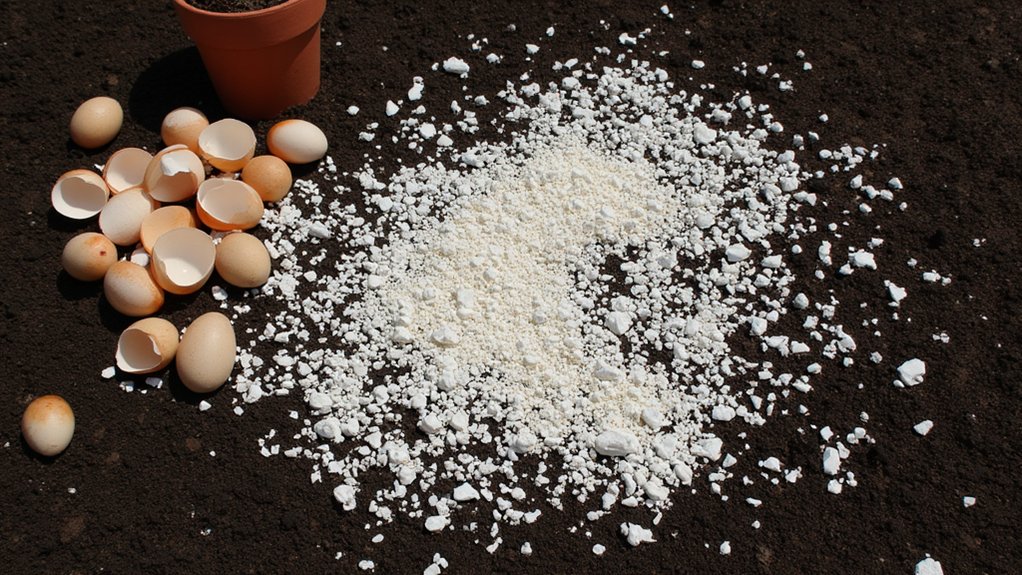
Something as simple as eggshells can boost your garden’s health with a dose of calcium. You’ve probably got some lying around after breakfast, so don’t toss them! Eggshells are packed with calcium carbonate, a nutrient that strengthens plant cell walls and prevents blossom end rot in tomatoes and peppers.
Here’s how you use them. First, rinse the shells to remove any egg residue, then let them dry completely for a day or two. Crush them into small pieces—about the size of a dime—using your hands or a rolling pin. Mix roughly 1 cup of crushed shells into a gallon of your compost or soil mix for a slow-release calcium boost over weeks.
Pretty easy, right? Your plants will thank you with stronger growth!
Incorporating Wood Ash
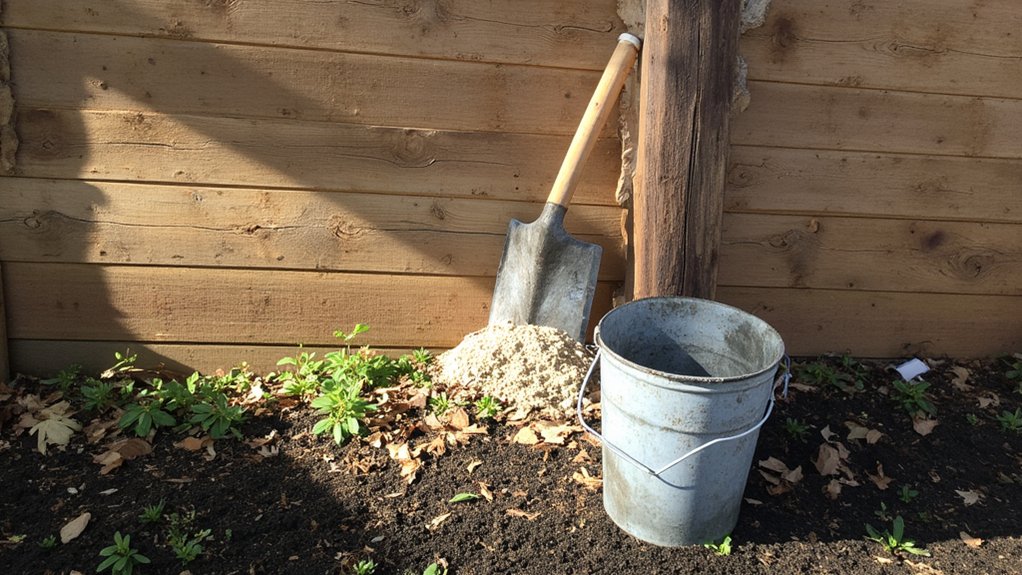
Let’s plunge into using wood ash, a fantastic source of potassium and trace minerals for your organic fertilizer. You’ve probably got some from a fireplace or bonfire, right? Just make certain it’s from untreated, natural wood—no painted or chemical-laden stuff.
First, collect about 1-2 cups of cooled ash for a small compost batch. Sprinkle it evenly over your pile, avoiding clumps, as this guarantees even distribution. Mix it in with a shovel or pitchfork, turning the compost thoroughly.
Mixing Seaweed Extracts
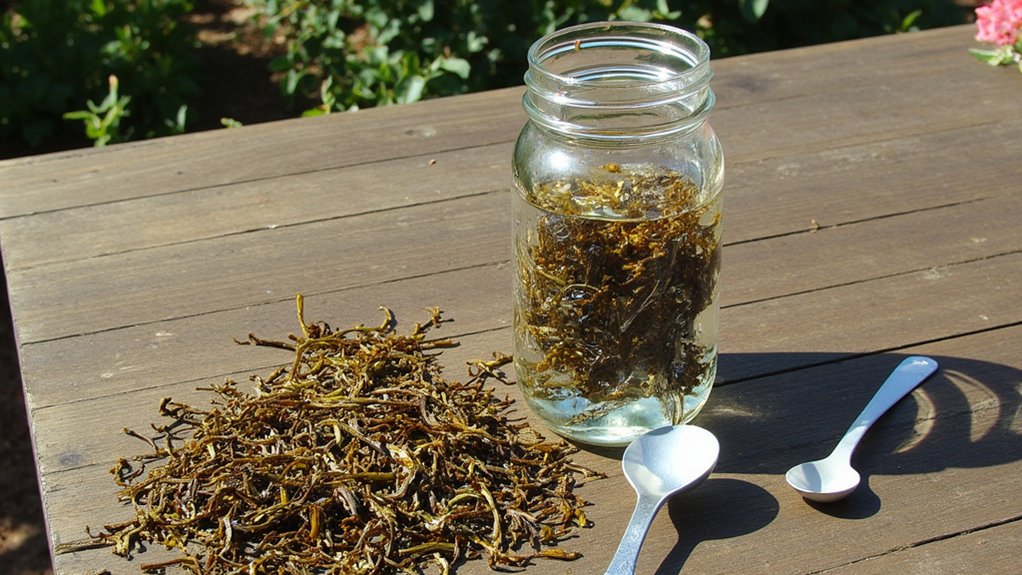
While you’re building your organic fertilizer, consider adding seaweed extracts for a nutrient-packed boost. They’re loaded with trace minerals, vitamins, and growth hormones that plants crave. Trust me, your garden will thank you for this!
Start by sourcing dried seaweed or liquid seaweed extract from a local store or online. Measure out about 2 tablespoons of dried seaweed per gallon of water, or follow the label for liquid versions. Soak the dried stuff for 24 hours, stirring occasionally, to release those goodies. Then, strain it if needed, and mix the liquid into your fertilizer base.
Don’t overdo it, though; too much can throw off the balance. Use this mix sparingly, about once a month, for steady, healthy plant growth.
Leveraging Manure Benefits

Hey, after boosting your mix with seaweed, turn your attention to manure for another powerful addition. It’s a nutrient goldmine, packed with nitrogen, phosphorus, and potassium. You can’t ignore its benefits for enriching your homemade fertilizer.
Start by sourcing well-rotted manure from cows, horses, or chickens—fresh stuff burns plants, so avoid it. Aim for manure that’s aged at least six months, dark and crumbly. Mix about 2 parts manure with 1 part compost or soil to balance it out.
Spread this blend into your fertilizer base, using roughly 5 pounds per 100 square feet of garden space. Let it sit for a week, turning occasionally, to integrate fully. You’ve now got a potent, organic boost for your plants!
Using Epsom Salt
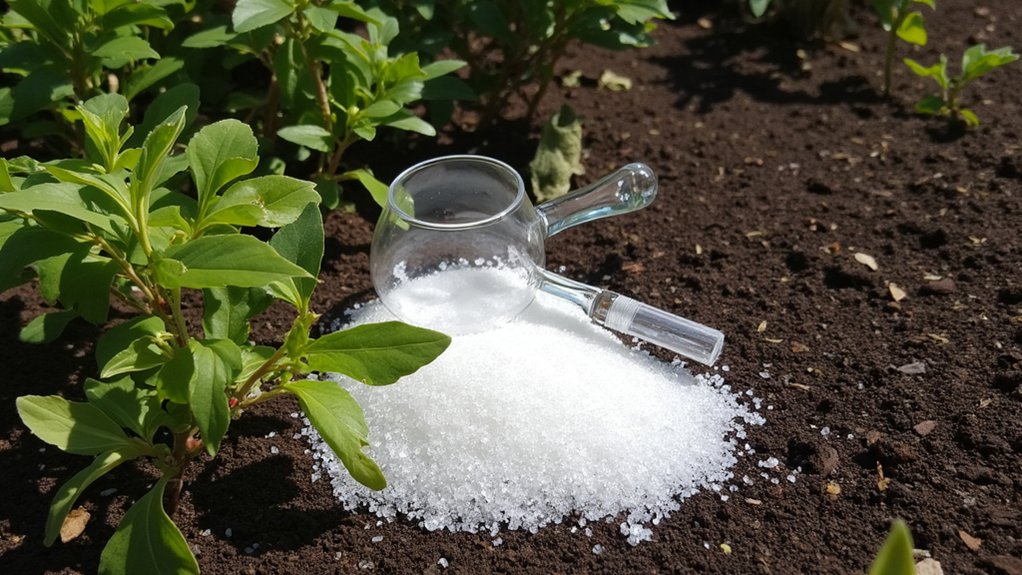
Moving on to Epsom salt, you’ve got a simple yet effective ingredient to supercharge your organic fertilizer. It’s packed with magnesium and sulfur, two nutrients plants crave for healthy growth. Don’t overlook this affordable gem; it’s easy to use!
Start by grabbing a bag of pure Epsom salt from a garden center or pharmacy. Dissolve 1 tablespoon of it in a gallon of water, stirring until it’s fully mixed. Use this solution to water your plants every two weeks, focusing on the soil around the roots.
Why does it work? Magnesium boosts photosynthesis, while sulfur aids in protein production. Just don’t overdo it—too much can mess with soil balance. Stick to the schedule, and watch your garden thrive!
